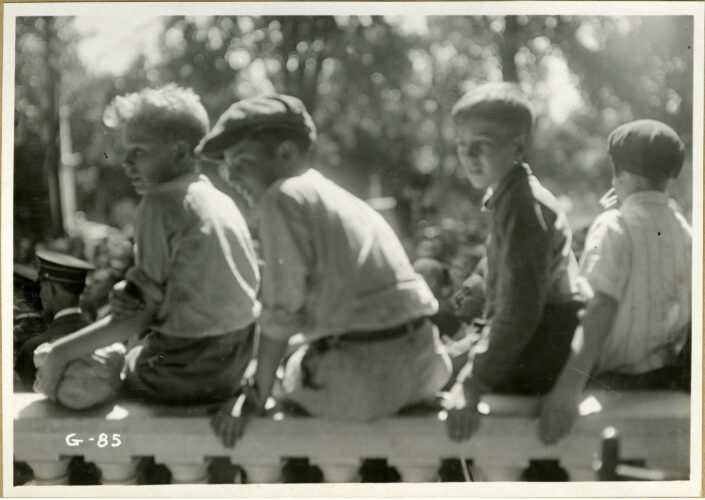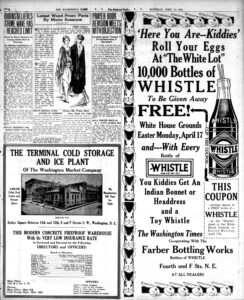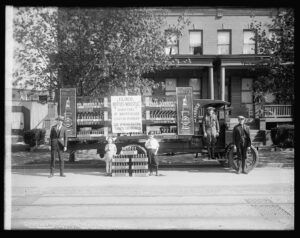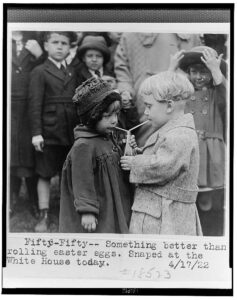Eggs and Orange Soda: The 1922 White House Easter Egg Roll

Nearly every Easter Monday since 1876, the President of the United States has hosted the White House Easter Egg Roll. It is mostly an event for children to come and play games with colorfully painted eggs, but also serves as a public celebration and gathering for people of all ages. By 1922, Ohio-born President Warren G. Harding’s second year in office, it was a firmly established tradition, and local D.C. newspapers reported thousands of attendees eager to observe Easter, celebrate springtime, and enjoy themselves at that year’s festivities.
Ahead of the 1922 Easter Egg Roll, The Washington Times newspaper asked C. O. Sherrill, the event’s supervisor, if they could provide 10,000 bottles of Whistle, an orange soda, to the children that would be attending. In their request they wrote that “the children will grow thirsty from their exertions of running around, and we thought free soda water would be appreciated by them”. How charitable and pure-intentioned! Or was it…
Sherrill accepted the Whistle proposition, but only within strict limitations, stipulating that “there will be no advertising matter distributed within the White House grounds”. The Easter Egg Roll was not to be a business or marketing opportunity for companies looking to line their pockets, but a wholesome event for the enjoyment and benefit of children. Any soda donation would be acceptable only if done in a “simple and unostentatious manner”.
The Washington Times promptly began publishing advertisements promoting the event and printed cut-out coupons for a free bottle of Whistle at the Easter Egg Roll. Ads also promised that kids would receive an Indian headdress and a toy whistle. Despite Sherrill’s warning, The Washington Times and their partners were heavily leaning into the Easter Egg Roll as a chance to build their brands.

On Easter Monday 1922, the White House’s south gates opened promptly at 9am, and three Farber Bottling Works trucks laden with Whistle entered shortly afterward, led by Mr. Farber himself. They had wholly disregarded their directions to not advertise to the children. Their trucks were covered in Whistle advertisements and signage, and the paper, faux-Indian headdresses prominently featured the word “Whistle” on them.

The park police promptly instructed that the soda was to be given to all children, whether or not they possessed a coupon, and the headdresses and whistles could not be distributed. They could only do so much, however, as children excitedly gathered around the trucks. The Washington Times described how “Eggs and chicks and bunnies and the rest of the Easter paraphernalia were entirely deserted in favor of Whistle”. The festivities continued, and the authorities admitted that the sodas contributed to the event’s “picnic spirit” and were greatly enjoyed by the children, who consumed 10,000 bottles of it.
The next day, Sherrill sent a report to President Harding on what he described as “an unfortunate occurrence” from the egg roll. He ended by telling the President, “I regret very much that the explicit condition contained in my letter of April 7th appears to have been ignored by the agency distributing this soda.” Through his secretary, Harding, who seems to have only made a brief appearance at the festivities anyway, curtly requested that he be personally consulted regarding such arrangements at future functions.

The annual Easter Egg Roll continues today and will be held at the White House on April 1, 2024. Just as The Washington Times and the Farber Bottling Works saw the Easter Egg Roll as a marketing opportunity in 1922, modern iterations of this event can also feature advertisements directed at kids. This can be seen by the attendance of people dressed as popular children’s mascots and 2015’s “Coca Cola Troops For Fitness” exercise area.
If you want to attend this year’s Easter Egg Roll, you can enter the ticket lottery online. But if travelling all the way to Washington is too far for you, there will also be an egg roll held at the Rutherford B. Hayes Presidential Home and Museum in Fremont, Ohio, the same day! Hayes did, after all, host the first Easter Egg Roll at the White House in 1876. No matter your plans, enjoy your Easter and the incoming spring!
Thank you to David McDevitt, Project Assistant at the Ohio History Connection, for this week’s post!



Leave a Reply
You must be logged in to post a comment.